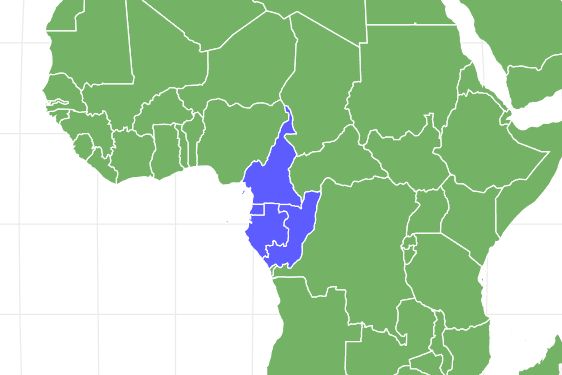Western Gorilla
Gorilla Gorilla
There are two sub-species!
Advertisement
Western Gorilla Scientific Classification
- Kingdom
- Animalia
- Phylum
- Chordata
- Class
- Mammalia
- Order
- Primates
- Family
- Hominidae
- Genus
- Gorilla
- Scientific Name
- Gorilla Gorilla
Read our Complete Guide to Classification of Animals.
Western Gorilla Conservation Status
Western Gorilla Facts
- Main Prey
- Leaves, Fruit, Flowers
- Habitat
- Rainforest and dense jungle
- Predators
- Human, Leopard, Crocodile
- Diet
- Herbivore
- Average Litter Size
- 1
View all of the Western Gorilla images!
When thinking of gorillas, most people conjure a vision of an angry, snarling great ape – beating his chest before charging to attack. Some might think of “King Kong” – another famous angry ape, or the gorillas in “Planet of the Apes” – more angry apes! In reality, gorillas are peace-loving creatures that like to hang out with their families, watch their kids at play, and eat fruit and bamboo shoots.
The western gorilla is one of two gorilla sub-groups found on the African continent (the other being the eastern gorilla). The western gorilla is the most numerous of the gorilla species and is found inhabiting the tropical jungles and forests of western and central Africa, along with lowland swamps and secondary forests. All western gorillas are now considered to be critically endangered as much of their natural habitat has now been deforested or taken over by humans.
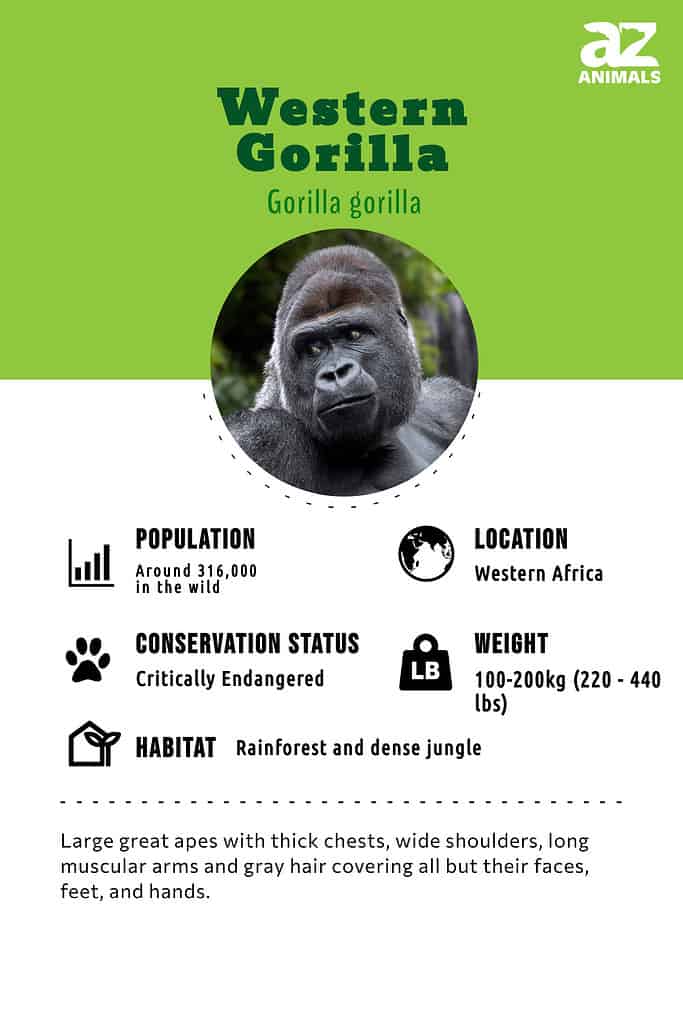
Species
The western gorilla is one of the great apes, a group that includes orangutans, gorillas, humans, and chimpanzees. As with the other great apes, the western gorilla has a number of features that makes living in the jungle a bit easier, including having opposable thumbs which come in handy when the western gorilla is peeling fruit.
There are two separate subspecies of the western gorillas which are the western lowland gorilla and the cross-river gorilla. Although only slightly different in appearance, the two western gorilla species are distinguished by their differing skull and tooth sizes.
Western Gorilla (Gorilla gorilla)
- Western lowland gorilla (G. gorilla gorilla)
- Cross River gorilla (G. g. diehli)
Eastern Gorilla (Gorilla beringie)
- Mountain gorilla (G.beringei beringei)
- Eastern lowland gorilla (G. b. graueri)

Gorillas are closely related to humans and share many traits.
©Cliff from Arlington, Virginia, USA, CC BY 2.0, via Wikimedia Commons – License
Evolution
Although not much is known about the evolution of gorillas, they are closely related to humans and chimpanzees. They all diverged from a common ancestor about 7 million years ago. Human gene sequences differ from gorilla sequences by only 1.6% on average.
Gorillas were previously thought to be a single species with three subspecies (Western lowland, eastern lowland, and mountain gorillas), but it is now agreed that there are two main species, the Western gorilla, (Gorilla gorilla) and the Eastern gorilla (Gorilla beringei), and they each have two subspecies. Western and Eastern gorillas split into two groups around 77,700 years ago.
Appearance and Behavior

Western silverback gorillas can weigh up to 440 pounds.
©Andreas Rose/Shutterstock.com
Western gorillas are certainly as strong as they appear to be – with thick chests, wide shoulders, and long, heavily muscled arms that they use to propel themselves on their knuckles. They are covered in dark, brown-gray fur except for their faces, hands, and feet; older males may also have bare chests. Adult males develop gray or silver hairs in a saddle pattern on their lower back which is why mature males are referred to as silverbacks.
The Western gorilla is smaller than the Eastern gorilla. They weigh anywhere from 220 to 440 pounds, while their Eastern counterparts weigh 450 – 500 pounds. Their height ranges from 4.7 to 5.5 feet, ranging from a child’s height or the average adult human height. Like other great apes, these gorillas have opposable thumbs, making using tools and other activities much easier.
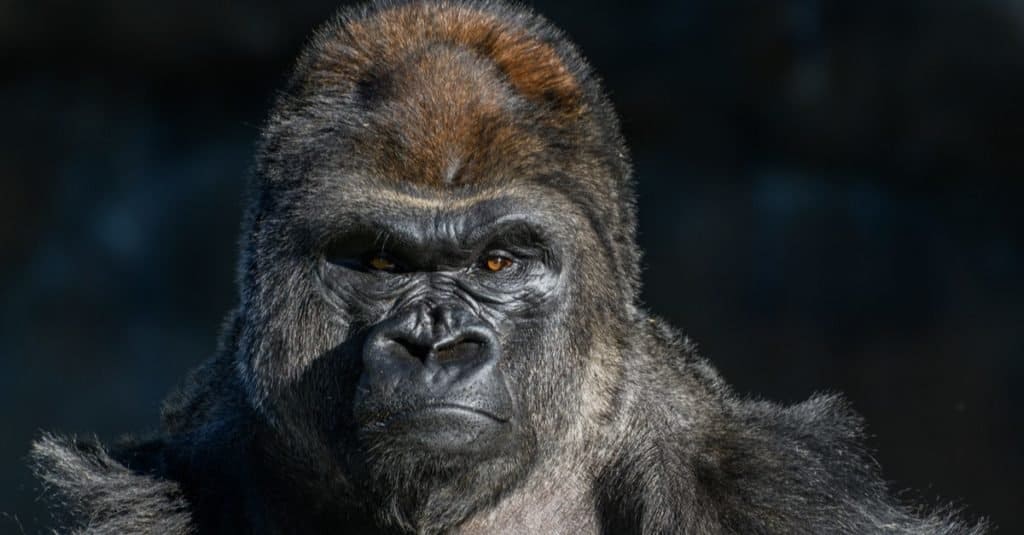
Male western gorillas are almost twice as large as females.
©Jeff W. Jarrett/Shutterstock.com
They have wider skulls than other gorillas, and their brow ridges are more pronounced. It is also far easier to distinguish the females from males in Western gorillas as the females are almost half the size of silverbacks.
How can you tell the difference between the Western gorilla and the Eastern? The Western gorilla’s hair is a dark brown-gray color, with a little bit of red or auburn on top of its head. Eastern gorillas have much darker hair and are larger.
A group of gorillas is called a troop or a band. They claim an area between one and 16 square miles and walk throughout that area to feed. Several bands may inhabit the same area without conflict. Western gorillas build nests of vegetation every night, either on the ground or in trees.
Diet
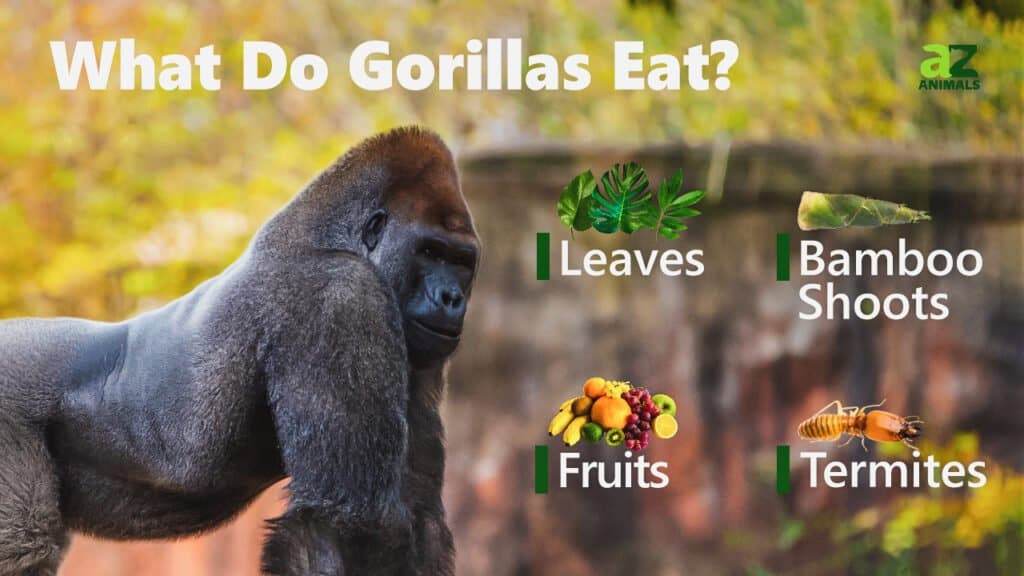
The western gorilla is an omnivorous animal, but the majority of its diet is made up of eating fruit – which they are known to travel vast distances through the forests to find. The western gorilla also eats leaves, nuts, and berries, along with insects and occasionally small animals such as lizards and rodents. The western gorilla has also been observed using basic tools in the wild in order to more effectively gather food.
Predators and Threats
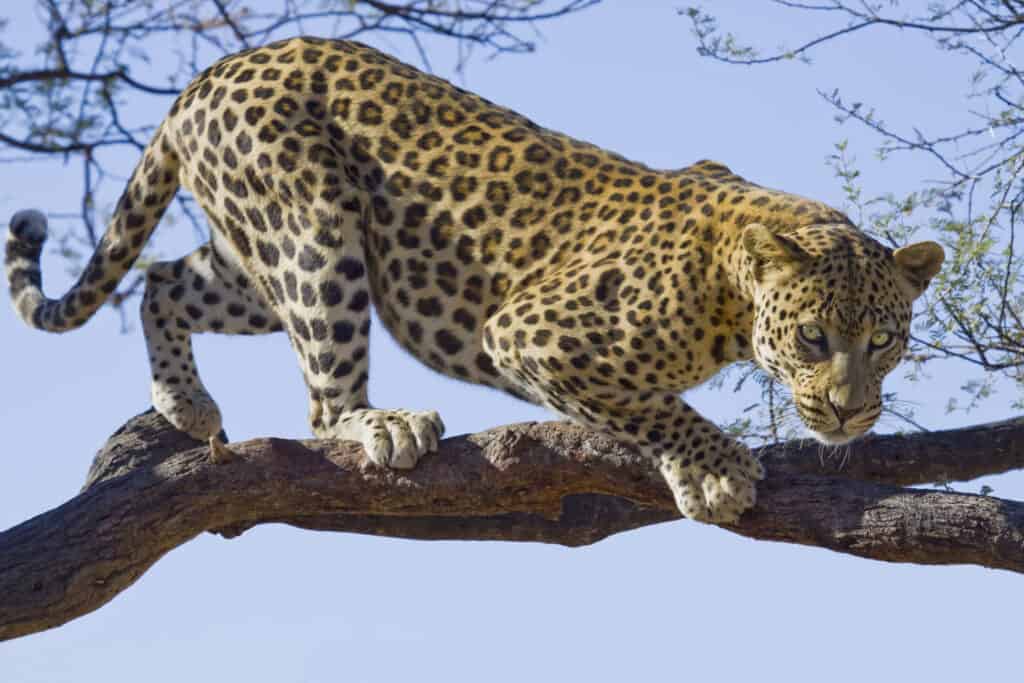
Leopards have been known to prey on gorillas.
©iStock.com/lightstock
Due to its large size, the western gorilla has few real predators in its native African forests, with large cats such as leopards and the odd crocodile being the only real natural threat to the western gorilla. The biggest threat to the western gorilla is habitat loss caused by deforestation and also being hunted by humans. Parts of the western gorilla’s territory have also been taken over by civil unrest in recent years, which, along with poaching, has had a truly devastating effect on wild populations.
Reproduction and Babies
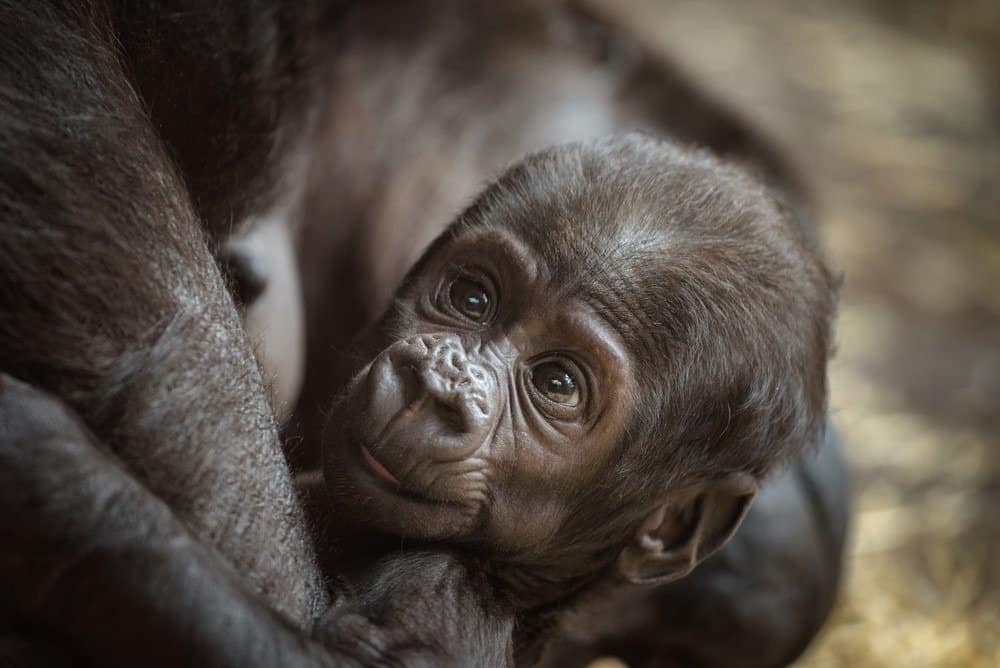
Baby gorillas are born helpless and need total care from their mothers.
©Nick Fox/Shutterstock.com
The western gorilla tends to live in groups that are led and protected by the alpha male. Females reach sexual maturity around the age of seven. Their gestational period is approximately eight and a half months long. On average, they give birth to a sole baby every four years. Males mature more slowly, and they attain maturity between 12 and 13 years. Upon reaching maturity, males leave the troop and form their own with adult females that they kidnap from other bands during raids. The juveniles of the troop are all fathered by the one or two silverbacks that lead the group.
Western gorilla babies remain with their mothers until they are a few years old and become independent. They are helpless from birth until about three months and spend most of their time being carried in their mother’s arms. Baby gorillas are able to cling to their mother’s chest or back, but they are not able to care for themselves or walk.
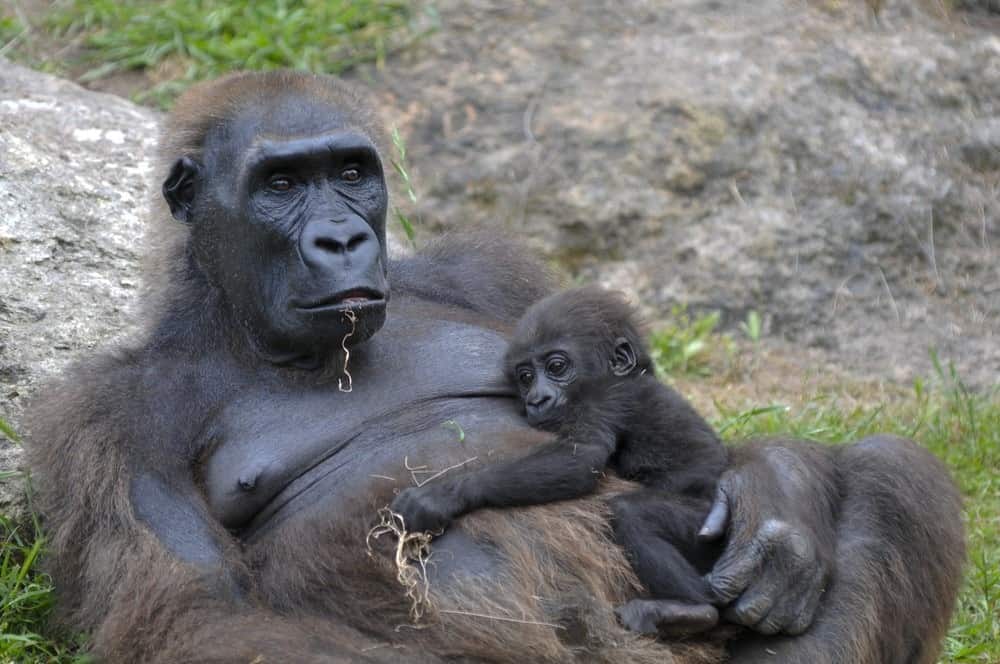
Western gorilla babies stay with their mothers for around 3 years.
©Boris Diakovsky/Shutterstock.com
Population
Today, all western gorillas are critically endangered species but there are thought to be 95,000 western lowland gorillas remaining in the wild, significantly more than their cross-river gorilla cousins, whose numbers in the wild are thought to be as low as 300 individuals.
View all 108 animals that start with WWestern Gorilla FAQs (Frequently Asked Questions)
Are Western Gorillas herbivores, carnivores, or omnivores?
Western Gorillas are Herbivores, meaning they eat plants.
What Kingdom do Western Gorillas belong to?
Western Gorillas belong to the Kingdom Animalia.
How fast is a Western Gorilla?
A Western Gorilla can travel at speeds of up to 25 miles per hour.
Thank you for reading! Have some feedback for us? Contact the AZ Animals editorial team.
Sources
- David Burnie, Dorling Kindersley (2011) Animal, The Definitive Visual Guide To The World's Wildlife
- Tom Jackson, Lorenz Books (2007) The World Encyclopedia Of Animals
- David Burnie, Kingfisher (2011) The Kingfisher Animal Encyclopedia
- Richard Mackay, University of California Press (2009) The Atlas Of Endangered Species
- David Burnie, Dorling Kindersley (2008) Illustrated Encyclopedia Of Animals
- Dorling Kindersley (2006) Dorling Kindersley Encyclopedia Of Animals
- David W. Macdonald, Oxford University Press (2010) The Encyclopedia Of Mammals

